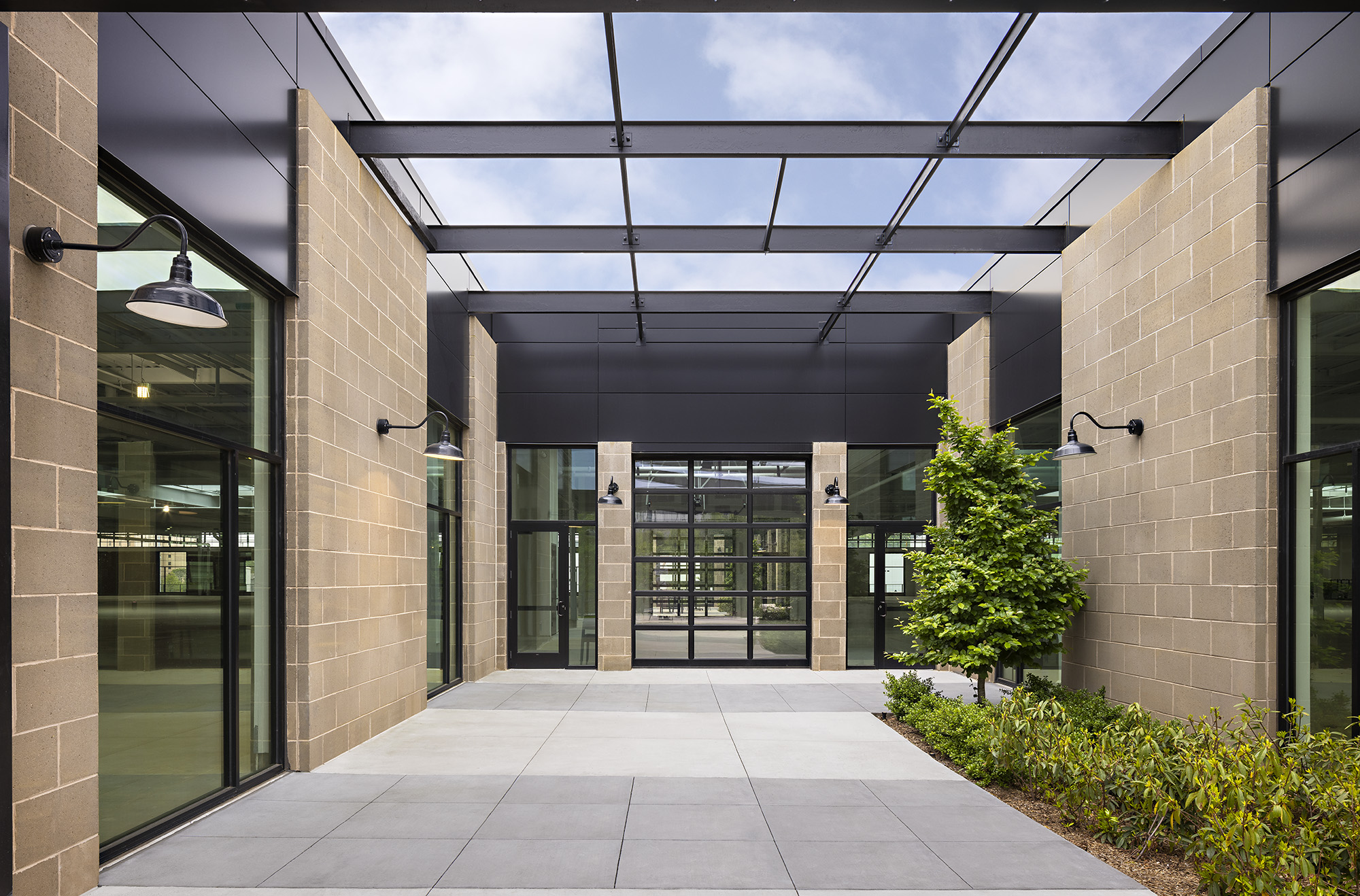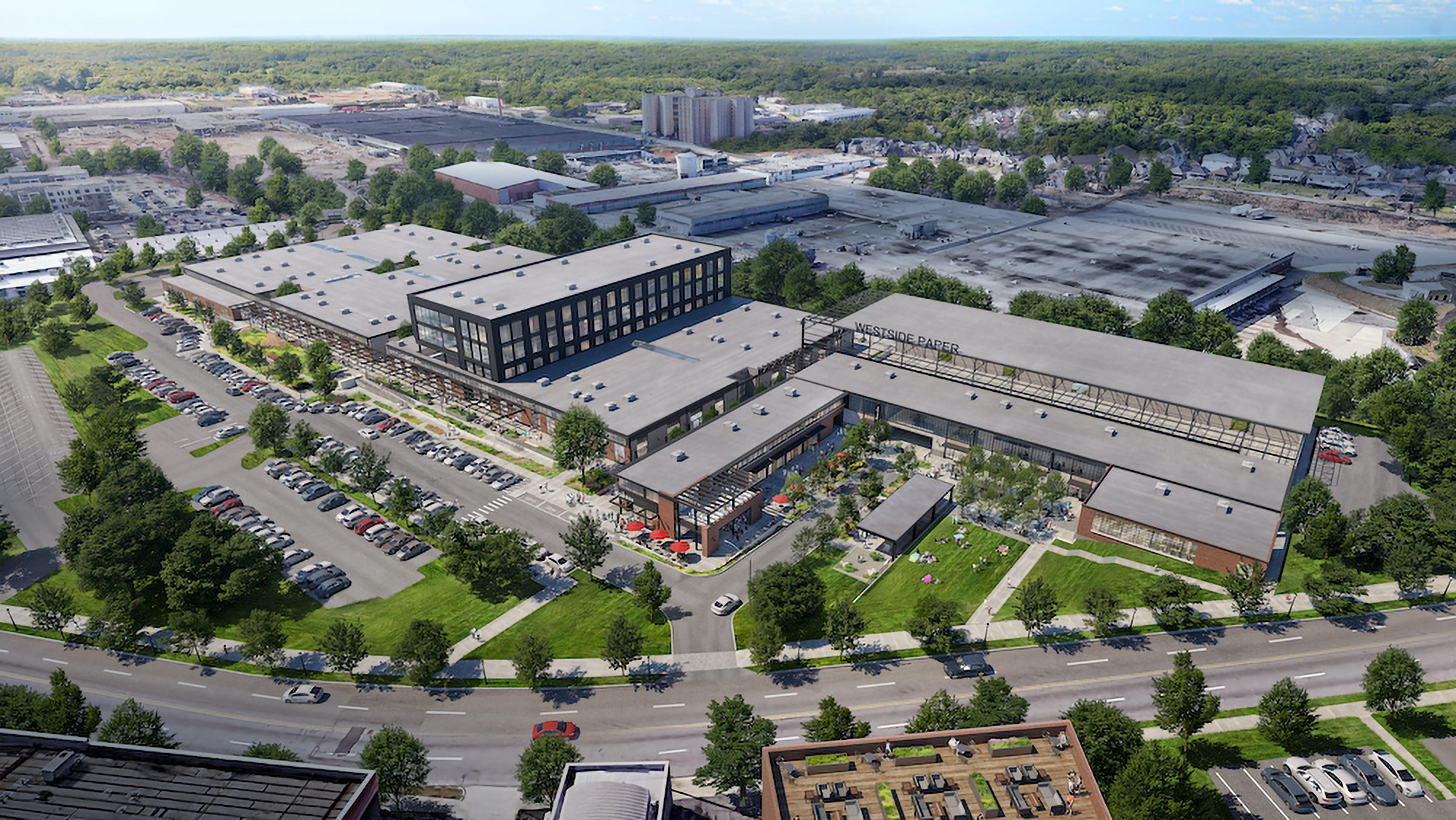An adaptive reuse project in Atlanta turned an obsolete Coca-Cola packaging warehouse into a vibrant mixed-use retail/restaurant/office complex. The 250,000-sf structure is located along a now defunct railroad line that forms the footprint for the city’s multi-phase Beltline pedestrian/bike path that will eventually loop around the city.
“With the Beltline Spur Trail planned for the abandoned railroad and other neighborhood transitions, the design goal became how to modernize the existing building while preserving its industrial history,” says Victoria Walsh, AIA, LEED AP, Architect, Perkins&Will. “Our big move was cutting up the warehouse into three separate parts. New promenades through the building allowed natural light, ventilation, and direct entry to the office and retail spaces.”
Westside Paper Mixed-Use Redevelopment

Contemporary elements were incorporated into the design to harmonize with the emerging Westside aesthetic. Echelon Masonry's Mondrian Stone provided a sleek, modern canvas for the darker steel elements and weathered brick walls.
The design preserved the steel armature framework overhead. Steel and glass clerestory windows were preserved and painted a dark bronze color that created a backdrop for the original masonry walls. “The light/dark contrast between the Mondrian Stone and painted bronze steel allowed for that clear delineation between old and new,” Walsh says.
The 15-acre location has already been leased by multiple vendors, with only a few spaces remaining.
“The neighborhood has rapidly changed with so much residential development moving in,” Walsh says. “Another adaptive reuse project King Plow—a former plow factory converted into a popular arts center, is just across the street.”

On the Building Team:
Owner and/or developer: FCP (Federal Capital Partners)
Design architect: Perkins&Will
Architect of record: Perkins&Will
MEP engineer: Barrett Woodyard
Structural engineer: Shear Structural
General contractor/construction manager: Gay Construction
Related Stories
Adaptive Reuse | Sep 15, 2023
Salt Lake City’s Frank E. Moss U.S. Courthouse will transform into a modern workplace for federal agencies
In downtown Salt Lake City, the Frank E. Moss U.S. Courthouse is being transformed into a modern workplace for about a dozen federal agencies. By providing offices for agencies previously housed elsewhere, the adaptive reuse project is expected to realize an annual savings for the federal government of up to $6 million in lease costs.
Office Buildings | Sep 14, 2023
New York office revamp by Kohn Pedersen Fox features new façade raising occupant comfort, reducing energy use
The modernization of a mid-century Midtown Manhattan office tower features a new façade intended to improve occupant comfort and reduce energy consumption. The building, at 666 Fifth Avenue, was originally designed by Carson & Lundin. First opened in November 1957 when it was considered cutting-edge, the original façade of the 500-foot-tall modernist skyscraper was highly inefficient by today’s energy efficiency standards.
Adaptive Reuse | Sep 13, 2023
Houston's first innovation district is established using adaptive reuse
Gensler's Vince Flickinger shares the firm's adaptive reuse of a Houston, Texas, department store-turned innovation hub.
MFPRO+ Research | Sep 11, 2023
Conversions of multifamily dwellings to ‘mansions’ leading to dwindling affordable stock
Small multifamily homes have historically provided inexpensive housing for renters and buyers, but developers have converted many of them in recent decades into larger, single-family units. This has worsened the affordable housing crisis, say researchers.
Adaptive Reuse | Aug 31, 2023
New York City creates team to accelerate office-to-residential conversions
New York City has a new Office Conversion Accelerator Team that provides a single point of contact within city government to help speed adaptive reuse projects. Projects that create 50 or more housing units from office buildings are eligible for this new program.
Adaptive Reuse | Aug 31, 2023
Small town takes over big box
GBBN associate Claire Shafer, AIA, breaks down the firm's recreational adaptive reuse project for a small Indiana town.
Adaptive Reuse | Aug 17, 2023
How to design for adaptive reuse: Don’t reinvent the wheel
Gresham Smith demonstrates the opportunities of adaptive reuse, specifically reusing empty big-box retail and malls, many of which sit unused or underutilized across the country.
Adaptive Reuse | Aug 16, 2023
One of New York’s largest office-to-residential conversions kicks off soon
One of New York City’s largest office-to-residential conversions will soon be underway in lower Manhattan. 55 Broad Street, which served as the headquarters for Goldman Sachs from 1967 until 1983, will be reborn as a residence with 571 market rate apartments. The 30-story building will offer a wealth of amenities including a private club, wellness and fitness activities.
Adaptive Reuse | Jul 27, 2023
Number of U.S. adaptive reuse projects jumps to 122,000 from 77,000
The number of adaptive reuse projects in the pipeline grew to a record 122,000 in 2023 from 77,000 registered last year, according to RentCafe’s annual Adaptive Reuse Report. Of the 122,000 apartments currently undergoing conversion, 45,000 are the result of office repurposing, representing 37% of the total, followed by hotels (23% of future projects).
Urban Planning | Jul 26, 2023
America’s first 100% electric city shows the potential of government-industry alignment
Ithaca has turned heads with the start of its latest venture: Fully decarbonize and electrify the city by 2030.

















